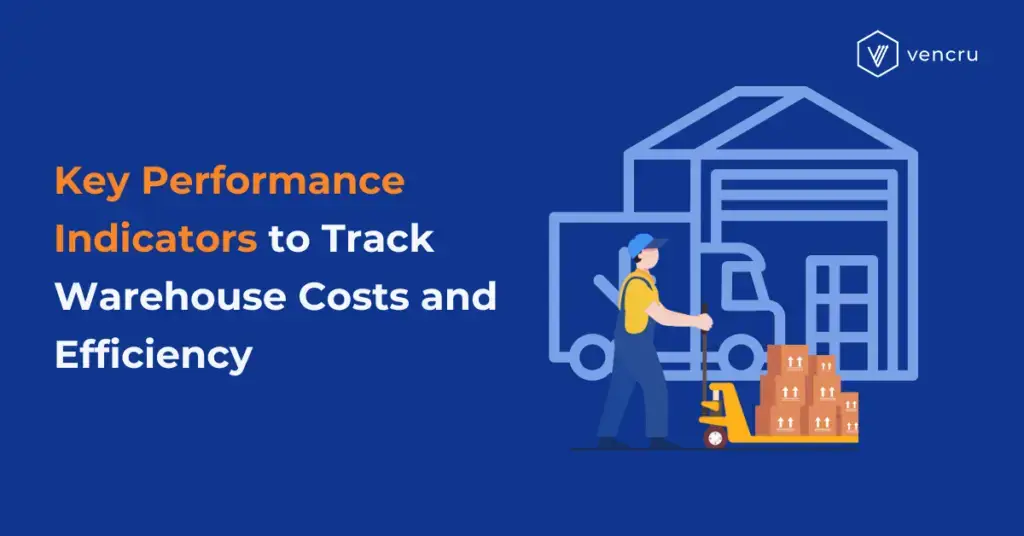Warehousing is an essential part of every supply chain. Warehouse management has a direct impact on customer satisfaction, order fulfillment speed, and overall profit. Tracking warehousing key performance indicators (KPIs) is one of the best practices for ensuring that your warehouse runs smoothly and efficiently. These metrics provide useful insights about warehouse operations and inventory management, as well as assist you in identifying areas for improvement.
By tracking the right KPIs, you can optimize your inventory levels, minimize costs, and ensure you have the right products on hand to meet customer demand. Throughout this blog, we’ll explore some essential KPIs to monitor for successful warehouse efficiency and what they can do for you.
Essential Warehouse Management KPIs
Inventory Management KPIs

Inventory Accuracy
Keeping accurate inventory records is crucial for running an efficient warehouse. This key performance indicator (KPI) actively measures the gap between your physical inventory count and the records in your inventory management systems. Accurate inventory control ensures better warehouse management, improves efficiency, and keeps your fulfillment process smooth. The closer your inventory accuracy is to 1, the better your warehouse management system (WMS) is performing.
Formula: Inventory as tracked by system / Physically present inventory
Carrying Cost of Inventory
The carrying cost of inventory is the total amount of money a business spends on owning, storing, and holding inventory. It represents how long your business can continue storing its inventory before you begin to lose money and need to find a new solution for slow-moving inventory and dead stock. Carrying costs can be calculated by dividing your total carrying costs by your average inventory costs.
Formula: Total carrying costs / Overall inventory costs
Inventory Turnover Rate
The inventory turnover rate measures how often inventory is sold and replaced over a specific period. High turnover indicates efficient inventory management, while low turnover can signal overstocking or slow-moving goods. Here’s the formula to calculate this KPI:
Formula: Cost of Goods Sold (COGS) / Average Inventory Value
Warehouse Operations KPIs

Receiving Efficiency
Warehouse receiving efficiency measures the time it takes to receive, inspect, and store incoming goods. Inefficient receiving processes can lead to delays in shipment and disrupt your entire warehouse workflow. Tracking this warehousing KPI helps you identify bottlenecks in your receiving procedures and implement strategies to speed up the process.
Formula: Volume of inventory received / Number of staff hours worked
Storage Usage
Storage usage measures the percentage of warehouse space that is currently occupied by inventory. Optimizing storage use can help you minimize storage costs and maximize the efficiency of your warehouse layout. Analyzing this warehousing KPI allows you to identify opportunities to optimize your warehouse layout or consider implementing space-saving storage solutions such as vertical storage solutions.
Rate of Return
The rate of return measures the percentage of products returned by customers. A high rate of return can indicate issues with product quality, order accuracy, or inventory management. Addressing the root causes of returns is essential for maintaining customer trust and improving warehouse efficiency.
Labor Costs
Warehouse labor costs are a significant expense. Tracking this KPI helps you understand the cost of labor per unit picked, shipped, or received. By monitoring labor costs, you can identify potential areas for cost reduction through process improvements or workforce optimization strategies.
Order Management KPIs

Picking Accuracy
Picking accuracy refers to the percentage of orders fulfilled with the correct items. Inaccurate picking can lead to delays, reduced customer satisfaction, and the need for returns. Monitoring picking accuracy allows you to identify areas for improvement in your picking processes and warehouse layout. Your picking accuracy should be as close as possible to 1, indicating no mistakes.
Formula: (Total number of orders – Incorrect item returns) / Total number of orders
Order Cycle Time
Order cycle time is the average time taken from receiving an order to its shipment. This KPI directly impacts customer satisfaction and delivery speed. Reducing order cycle time involves streamlining warehouse processes, employing efficient warehouse management systems, and optimizing labor deployment.
Order Fulfillment Cost
The order fulfillment cost is the total expense incurred to process an order, including labor, packing materials, and shipping costs. Lowering this KPI can significantly boost profit. Efficient warehouse operations, strategic resource allocation, and cost-effective inventory management practices are key to reducing the cost per order.
Safety KPIs

Incident Rate
The incident rate tracks how many workplace accidents happen per 100 employees over a certain period. Monitoring this KPI is one of the warehousing best practices as it helps identify safety hazards in your warehouse management. By using a warehouse management system (WMS), you can keep a closer eye on these incidents and implement measures to prevent accidents. Ensuring safety in your supply chain management and inventory control processes, including pick and pack, order picking, and cycle counts, leads to a smoother fulfillment process.
Formula: (Number of recordable incidents / Total number of employees) x 100 (adjusted for the chosen period – daily, weekly, monthly, yearly)
Days Since Last Incident
The number of days since the last incident is a key indicator of how well your safety protocols are working. More days without accidents show a safer work environment. This is crucial for warehouse management and supply chain management, ensuring the safety of warehouse staff while improving efficiency in inventory control, pick and pack, and the overall fulfillment process.
How to Choose the Right KPIs for Your Warehouse
1. Align KPIs with Warehouse Goals:
Start by clearly defining your warehouse goals. Are you aiming to improve order fulfillment speed, reduce inventory carrying costs, or enhance picking accuracy? Once you identify your primary objectives, select KPIs that directly track progress toward those goals.
2. Consider Warehouse Size and Complexity:
The number of KPIs you monitor may vary depending on the size and complexity of your warehouse. Larger warehouses with intricate operations might require a more comprehensive set of KPIs, while smaller warehouses can focus on a core set of essential metrics.
3. Industry Benchmarks:
Research industry benchmarks for relevant KPIs in your sector. This will provide a reference point to compare your warehouse’s performance against competitors and identify areas for improvement.
4. Track Over Time:
By tracking trends and fluctuations, you can identify areas that require attention and measure the effectiveness of implemented improvements.
5. Focus on Actionable Insights:
The data from the KPIs should empower you to make informed decisions and implement strategies to optimize your warehouse operations. Avoid getting bogged down in tracking metrics that don’t offer clear direction for improvement.
Related Read: Warehouse Management: 10 Best Practices
Implementing Warehouse Best Practices with Vencru

Efficient warehouse management is not just about tracking warehousing KPIs, it’s also about leveraging the right tools to streamline operations. Vencru offers a user-friendly platform that streamlines inventory management, order fulfillment, and reporting implementing the best practices for warehousing. With Vencru, you can:
- Track inventory levels by location in real time to minimize stockouts and overstocking.
- Monitor stock movements and manage stock transfers between locations.
- Improve picking accuracy with barcode scanning.
- Automate order processing for faster fulfillment times.
- Generate comprehensive reports, allowing you to identify areas for improvement and optimize your warehouse operations.
Related Read: 5 Best Small Warehouse Inventory Management Software
Conclusion
Tracking the right warehouse KPIs is essential for achieving warehouse efficiency and maximizing profit. By monitoring these key metrics and implementing strategies to improve them, you can ensure your warehouse operates smoothly, fulfills orders accurately and quickly, and ultimately contributes to a successful business.
Ready to transform your warehouse management? Explore Vencru here or book a demo.






